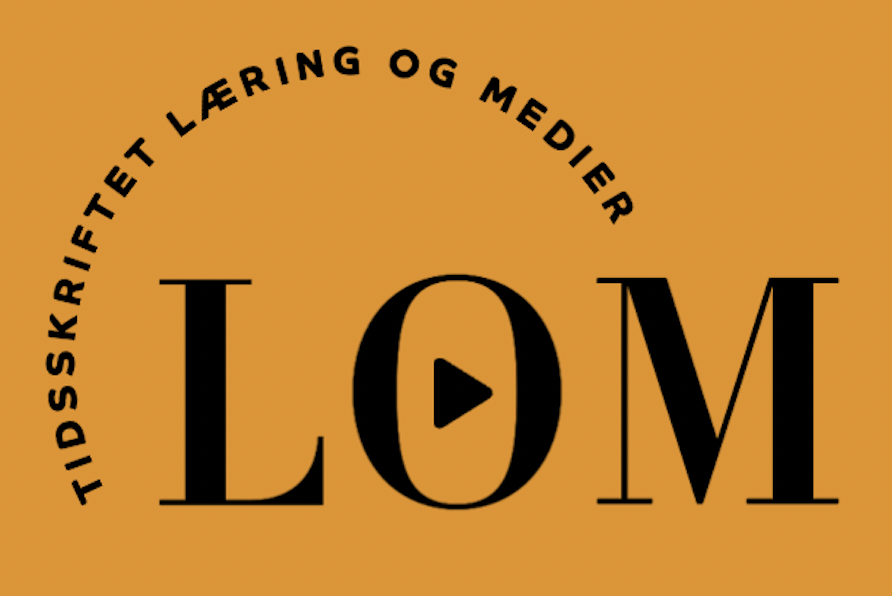Studenterproduceret video til eksamen
DOI:
https://doi.org/10.7146/lom.v9i15.23118Keywords:
læringsdesign, stilladsering, universitetspædagogik, videoproduktion, eksamen, video til eksamen, undervisningsplanlægningAbstract
Formålet med denne artikel er at vise, hvordan læringsdesign og stilladsering kan anvendes til at skabe en ramme for studenterproduceret video til eksamen på videregående uddannelser. Artiklen tager udgangspunkt i en problemstilling, hvor uddannelsesinstitutionerne skal håndtere og koordinere undervisning inden for både det faglige område og mediefagligt område og sikre en balance mellem en fagfaglighed og en mediefaglig tilgang. Ved at dele opgaven ud på flere faglige resurser, er der mere koordinering, men man kommer omkring problemet med krav til underviserne om dobbelt faglighed ved medieproduktioner. Med afsæt i Lanarca Declarationens perspektiver på læringsdesign og hovedsageligt Jerome Bruners principper for stilladsering, sammensættes en model for understøttelse af videoproduktion af studerende på videregående uddannelser. Ved at anvende denne model for undervisningssessioner og forløb får de fagfaglige og mediefaglige undervisere et redskab til at fokusere og koordinere indsatsen frem mod målet med, at de studerende producerer og anvender video til eksamen.Downloads
References
Andreasen, L. B., Buhl, M., Levinsen, K., & Ørngreen, R. (2011). Videoproduktioner som læringsressource i universitetsundervisning. I B. Meyer, It-didaktisk design - Cursiv nr. 8 (s. 59-83). Aarhus Universitet.
Belland, B. R. (2013). Scaffolding: Definition, Current Debates, and Future Directions. I J. Spector, M. Merrill, J. Elen, & M. Bishop, Handbook of Research on Educational Communications and Technology (s. 505-518). Springer.
Britain, S. (2004). A Review of Learning Design - Concept, Specifications and Tools. A report for the JISC E-learning Pedagogy Programme.
Bruce, D. L., & Chiu, M. M. (2015). Composing With New Technology Teacher Reflections on Learning Digital. Journal of Teacher Education, s. 272-287.
Bruner, J. (1961). The Act of Discovery. Harvard Educational Review, s. 21-32.
Bruner, J. (1993). Acts of Meaning. Harvard University Press.
Bruner, J. (1996). The Culture of Education. Harvard University Press.
Buckingham, D. (2006). Defining digital literacy - What do young people need to know about digital media? Digital Kompetense Vol. 1, s. 263-276.
Bundsgaard, J., Pettersson, M., & Puck, R. M. (2014). Digitale kompetencer - It i danske skoler i et internationalt perspektiv.
Cameron, L. (2009). How learning design can illuminate teaching pratice. The Future of Learning Design Conference Paper 3., s. 20-27. Hentet fra http://ro.uow.edu.au.
Clark, D. (2002). Psychological myths in e-learning. Med.Teach, s. 598-604.
Csikszentmihalyi, M. (1996). Creativity: Flow and the psychology of discovery and invention. Harper and Collins.
Csikszentmihalyi, M. (2008). Selvets udvikling -evolution, flow og det gode samfund. Dansk psykologisk Forlag.
Dalziel, J., Conole, G., Wills, S., Walker, S., Bennett, S., Dobozy, E., . . . Bower, M. (2013). The Larnaca Declaration on Learning Design. Hentet fra The Larnaca Declaration on Learning Design: http://www.larnacadeclaration.org/
Falconer, I., Finlay, J., & Fincher, S. (2011). Representing Practice: practice models, patterns, bundles. Media and Technology, Vol. 36, No. 2, s. 101-127.
Ferrari, A., Punie, Y., & Redecker, C. (2012). Digital Competence in Practice: An Analysis of Frameworks. Luxembourg: Publications Office of the European Union.
Greener, S., & Wakefield, C. (2015). Developing Confidence in the Use of Digital Tools in Teaching. Electronic Journal of e-Learning, v13 n4, s. 260-267.
Hofer, M., & Swan O, K. (2008). Technological Pedagogical Content Knowledge in Action: A Case Study of a Middle School Digital Documentary Project. Journal of Research on Technology in Education (International Society for Technology in Education), s. 179-200.
Holmberg, J. (2014). Studying the process of educational design – revisiting Schön and making a case for reflective design-based research on teachers’ ‘conversations with situations’. Technology, Pedagogy and Education Vol. 23, No. 3, s. 293-310.
Kress, G. (2003). Literacy in the New Media Age. London: Routledge.
Maina, M., Craft, B., & Mor, Y. (2015). The Art & Science of Learning Design. Rotterdam: Sense Publishers.
Mishra, P., & Koehler, M. J. (2008). Introducing Technological Pedagogical Content Knowledge. I I. T. Technology, The Handbook of Technological Pedagogical Content Knowledge forTeaching and Teacher Educators (s. 3-29). New York & London: Routledge.
Møller, A. (2004). Den kompetente netunderviser - underviserkompetencer i det virtuelle læringsmiljø. Tidsskrift for universiteternes efter- og videreuddannelse, 1. årgang, nr. 4, 2004.
Northern Illinois University. (2016). Instructional Scaffolding to Improve Learning. Hentet fra http://www.niu.edu: http://www.niu.edu/facdev/resources/guide/strategies/instructional_scaffolding_to_improve_learning.pdf
Nørgård, C. F.-J. (2004). Digitalisering af færdighedstræning og laboratorieøvelser. Tidsskriftet Læring og Medier (LOM).
Ottestad, G., Kelentrić, M., & Guðmundsdóttir, G. B. (2014). Professional Digital Competence in Teacher Education. Nordic Journal of Digital Literacy Vol. 9 nr. 4-2014, s. 244-249.
Pinantoan, A. (2013). Inform Ed. Hentet fra Instructional Scaffolding: A Definitive Guide: http://www.opencolleges.edu.au/informed/teacher-resources/scaffolding-in-education-a-definitive-guide/
Salmon, G. (2011). Emoderating - The key to teaching and learning online. New York: Routledge.
Weppel, S. D. (2015). gpstrategies.com. Hentet fra The Design of Scaffolding in Game-based Learning: A Formative Evaluation: http://www.gpstrategies.com/astd2014/docs/wpScaffolding.pdf
Wood, D., Bruner, J. S., & Ross, G. (1976). The role of tutoring in problem solving. Journal of child psychology and psychiatry, Oxford New York : Pergamon Press, s. 89-100.
Downloads
Published
How to Cite
Issue
Section
License

Articles published in the Journal of Learning and Media are licensed under a Creative Commons Attribution-NonCommercial-NoDerivatives 3.0 Unported Licens.
Authors retain copyright and grant the journal right of first publication; simultaneously articles are licensend under the Creative Commons Attribution license: Attribution-NonCommercial-NoDerviatives (by-nc-nd). Read about this license at https://creativecommons.org/licenses/by-nc-nd/3.0/
---
At LOM.dk, you will also find articles from the discontinued Journal for the Continuing and Further Education of the Danish Universities (UNEV). Note that special rules apply to UNEV articles:
It is the authors and any other copyright holder who have the copyright of articles published under the auspices of UNEV, and access to the articles is contingent on users acknowledging and complying with the associated legal guidelines:
- Users may download and print one copy of any UNEV publication for private studies or research.
- The redistribution of articles or the use of these for revenue-funded activities or commercial purposes are not allowed.
- It is not allowed to distribute the URLs of UNEV articles.

